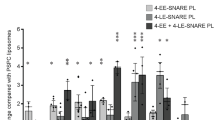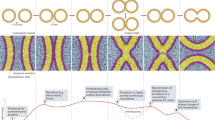Abstract
Rab GTPases and SNAREs (soluble N-ethylmaleimide-sensitive factor attachment protein receptors) are evolutionarily conserved essential components of the eukaryotic intracellular transport system. Although pairing of cognate SNAREs is sufficient to fuse membranes in vitro, a complete reconstitution of the Rab–SNARE machinery has never been achieved. Here we report the reconstitution of the early endosomal canine Rab5 GTPase, its key regulators and effectors together with SNAREs into proteoliposomes using a set of 17 recombinant human proteins. These vesicles behave like minimal ‘synthetic’ endosomes, fusing with purified early endosomes or with each other in vitro. Membrane fusion measured by content-mixing and morphological assays requires the cooperativity between Rab5 effectors and cognate SNAREs which, together, form a more efficient ‘core machinery’ than SNAREs alone. In reconstituting a fusion mechanism dependent on both a Rab GTPase and SNAREs, our work shows that the two machineries act coordinately to increase the specificity and efficiency of the membrane tethering and fusion process.
This is a preview of subscription content, access via your institution
Access options
Subscribe to this journal
Receive 51 print issues and online access
$199.00 per year
only $3.90 per issue
Buy this article
- Purchase on Springer Link
- Instant access to full article PDF
Prices may be subject to local taxes which are calculated during checkout





Similar content being viewed by others
Change history
25 January 2024
A Correction to this paper has been published: https://doi.org/10.1038/s41586-024-07063-2
References
Pfeffer, S. R. Transport-vesicle targeting: tethers before SNAREs. Nature Cell Biol.1, E17–E22 (1999)
Zerial, M. & McBride, H. Rab proteins as membrane organizers. Nature Rev. Mol. Cell Biol.2, 107–117 (2001)
Grosshans, B. L., Ortiz, D. & Novick, P. Rabs and their effectors: achieving specificity in membrane traffic. Proc. Natl Acad. Sci. USA103, 11821–11827 (2006)
Jahn, R. & Scheller, R. H. SNAREs—engines for membrane fusion. Nature Rev. Mol. Cell Biol.7, 631–643 (2006)
McNew, J. A. et al. Compartmental specificity of cellular membrane fusion encoded in SNARE proteins. Nature407, 153–159 (2000)
Rothman, J. E. & Sollner, T. H. Throttles and dampers: controlling the engine of membrane fusion. Science276, 1212–1213 (1997)
Cai, H., Reinisch, K. & Ferro-Novick, S. Coats, tethers, Rabs, and SNAREs work together to mediate the intracellular destination of a transport vesicle. Dev. Cell12, 671–682 (2007)
Christoforidis, S., McBride, H. M., Burgoyne, R. D. & Zerial, M. The Rab5 effector EEA1 is a core component of endosome docking. Nature397, 621–625 (1999)
Wang, L., Merz, A. J., Collins, K. M. & Wickner, W. Hierarchy of protein assembly at the vertex ring domain for yeast vacuole docking and fusion. J. Cell Biol.160, 365–374 (2003)
Weber, T. et al. SNAREpins: minimal machinery for membrane fusion. Cell92, 759–772 (1998)
Wickner, W. & Schekman, R. Membrane fusion. Nature Struct. Mol. Biol.15, 658–664 (2008)
Zimmerberg, J. & Gawrisch, K. The physical chemistry of biological membranes. Nature Chem. Biol.2, 564–567 (2006)
Schuette, C. G. et al. Determinants of liposome fusion mediated by synaptic SNARE proteins. Proc. Natl Acad. Sci. USA101, 2858–2863 (2004)
Fix, M. et al. Imaging single membrane fusion events mediated by SNARE proteins. Proc. Natl Acad. Sci. USA101, 7311–7316 (2004)
Liu, T. et al. SNARE-driven, 25-millisecond vesicle fusion in vitro . Biophys. J.89, 2458–2472 (2005)
Parlati, F. et al. Rapid and efficient fusion of phospholipid vesicles by the alpha-helical core of a SNARE complex in the absence of an N-terminal regulatory domain. Proc. Natl Acad. Sci. USA96, 12565–12570 (1999)
Pobbati, A. V., Stein, A. & Fasshauer, D. N- to C-terminal SNARE complex assembly promotes rapid membrane fusion. Science313, 673–676 (2006)
Brandhorst, D. et al. Homotypic fusion of early endosomes: SNAREs do not determine fusion specificity. Proc. Natl Acad. Sci. USA103, 2701–2706 (2006)
Sonnichsen, B. et al. Distinct membrane domains on endosomes in the recycling pathway visualized by multicolor imaging of Rab4, Rab5, and Rab11. J. Cell Biol.149, 901–914 (2000)
Barbero, P., Bittova, L. & Pfeffer, S. R. Visualization of Rab9-mediated vesicle transport from endosomes to the trans-Golgi in living cells. J. Cell Biol.156, 511–518 (2002)
Horiuchi, H. et al. A novel Rab5 GDP/GTP exchange factor complexed to Rabaptin-5 links nucleotide exchange to effector recruitment and function. Cell90, 1149–1159 (1997)
Christoforidis, S. et al. Phosphatidylinositol-3-OH kinases are Rab5 effectors. Nature Cell Biol.1, 249–252 (1999)
Shin, H. W. et al. An enzymatic cascade of Rab5 effectors regulates phosphoinositide turnover in the endocytic pathway. J. Cell Biol.170, 607–618 (2005)
Nielsen, E. et al. Rabenosyn-5, a novel Rab5 effector, is complexed with hVPS45 and recruited to endosomes through a FYVE finger domain. J. Cell Biol.151, 601–612 (2000)
Schnatwinkel, C. et al. The Rab5 effector Rabankyrin-5 regulates and coordinates different endocytic mechanisms. PLoS Biol.2, 1363–1380 (2004)
McBride, H. M. et al. Oligomeric complexes link Rab5 effectors with NSF and drive membrane fusion via interactions between EEA1 and syntaxin 13. Cell98, 377–386 (1999)
Hoepfner, S. et al. Modulation of receptor recycling and degradation by the endosomal kinesin KIF16B. Cell121, 437–450 (2005)
Del Conte-Zerial, P. et al. Membrane identity and GTPase cascades regulated by toggle and cut-out switches. Mol. Syst. Biol.4, 206 (2008)
Zwilling, D. et al. Early endosomal SNAREs form a structurally conserved SNARE complex and fuse liposomes with multiple topologies. EMBO J.26, 9–18 (2007)
Bhalla, A., Chicka, M. C., Tucker, W. C. & Chapman, E. R. Ca2+-synaptotagmin directly regulates t-SNARE function during reconstituted membrane fusion. Nature Struct. Mol. Biol.13, 323–330 (2006)
Dennison, S. M., Bowen, M. E., Brunger, A. T. & Lentz, B. R. Neuronal SNAREs do not trigger fusion between synthetic membranes but do promote PEG-mediated membrane fusion. Biophys. J.90, 1661–1675 (2006)
Starai, V. J., Jun, Y. & Wickner, W. Excess vacuolar SNAREs drive lysis and Rab bypass fusion. Proc. Natl Acad. Sci. USA104, 13551–13558 (2007)
Ullrich, O., Horiuchi, H., Bucci, C. & Zerial, M. Membrane association of Rab5 mediated by GDP-dissociation inhibitor and accompanied by GDP/GTP exchange. Nature368, 157–160 (1994)
Mayer, A., Wickner, W. & Haas, A. Sec18p (NSF)-driven release of Sec17p (α-SNAP) can precede docking and fusion of yeast vacuoles. Cell85, 83–94 (1996)
Rybin, V. et al. GTPase activity of Rab5 acts as a timer for endocytic membrane fusion. Nature383, 266–269 (1996)
Sivars, U., Aivazian, D. & Pfeffer, S. R. Yip3 catalyses the dissociation of endosomal Rab–GDI complexes. Nature425, 856–859 (2003)
Simonsen, A., Gaullier, J. M., D'Arrigo, A. & Stenmark, H. The Rab5 effector EEA1 interacts directly with syntaxin-6. J. Biol. Chem.274, 28857–28860 (1999)
Ungermann, C., Price, A. & Wickner, W. A new role for a SNARE protein as a regulator of the Ypt7/Rab-dependent stage of docking. Proc. Natl Acad. Sci. USA97, 8889–8891 (2000)
Mima, J. et al. Reconstituted membrane fusion requires regulatory lipids, SNAREs and synergistic SNARE chaperones. EMBO J.27, 2031–2042 (2008)
Takamori, S. et al. Molecular anatomy of a trafficking organelle. Cell127, 831–846 (2006)
Weber, T. et al. SNAREpins are functionally resistant to disruption by NSF and alphaSNAP. J. Cell Biol.149, 1063–1072 (2000)
Collins, K. M. & Wickner, W. T. Trans-SNARE complex assembly and yeast vacuole membrane fusion. Proc. Natl Acad. Sci. USA104, 8755–8760 (2007)
Kobayashi, T. et al. A lipid associated with the antiphospholipid syndrome regulates endosome structure and function. Nature392, 193–197 (1998)
Pfeffer, S. & Aivazian, D. Targeting Rab GTPases to distinct membrane compartments. Nature Rev. Mol. Cell Biol.5, 886–896 (2004)
Dulubova, I. et al. Munc18–1 binds directly to the neuronal SNARE complex. Proc. Natl Acad. Sci. USA104, 2697–2702 (2007)
Shen, J. et al. Selective activation of cognate SNAREpins by Sec1/Munc18 proteins. Cell128, 183–195 (2007)
Martens, S., Kozlov, M. M. & McMahon, H. T. How synaptotagmin promotes membrane fusion. Science316, 1205–1208 (2007)
Rink, J., Ghigo, E., Kalaidzidis, Y. & Zerial, M. Rab conversion as a mechanism of progression from early to late endosomes. Cell122, 735–749 (2005)
Peplowska, K. et al. The CORVET tethering complex interacts with the yeast Rab5 homolog Vps21 and is involved in endo-lysosomal biogenesis. Dev. Cell12, 739–750 (2007)
Bartlett, G. R. Colorimetric assay methods for free and phosphorylated glyceric acids. J. Biol. Chem.234, 469–471 (1959)
Acknowledgements
We are grateful to K. Simons and B. Hoflack for discussions, to C. Stroupe and W. Wickner for sharing unpublished information, and to G. Marsne, I. Baines, W. Huttner, K. Simons, C. Stroupe and W. Wickner for critical reading of the manuscript. We acknowledge support by the systems biology network HepatoSys of the German Ministry for Education and Research (BMBF, grant 0313082J), the EU Integrated Project EndoTrack, the DFG and the Max Planck Society (including the Max Planck Partner Group grant to M.Z. and M.M.). T.O. was supported by The Nakatomi Foundation.
Author Contributions M.M. conducted the initial studies and tested the recombinant proteins in endosome fusion and the membrane recruitment of Rab5 and its effectors on proteoliposomes, and B.L. further developed such a proteoliposome system. D.D. and A.R. established several of the protocols of purification of recombinant proteins. T.O. completed the development of these procedures and conducted all biochemical experiments on membrane fusion reported in this study. Ü.C. performed the electron microscopy analysis, Y.K. did the statistical analysis and the mathematical model of membrane fusion, and M.Z. conceived and directed the project and wrote the manuscript with the help of T.O., M.M. and Y.K.
Author information
Authors and Affiliations
Corresponding author
Supplementary information
Supplementary Information
This file contains Supplementary Methods, Supplementary References, Supplementary Figures 1-5 with Legends and Supplementary Table 1. (PDF 846 kb)
Rights and permissions
About this article
Cite this article
Ohya, T., Miaczynska, M., Coskun, Ü. et al. Reconstitution of Rab- and SNARE-dependent membrane fusion by synthetic endosomes. Nature 459, 1091–1097 (2009). https://doi.org/10.1038/nature08107
Received:
Accepted:
Published:
Issue Date:
DOI: https://doi.org/10.1038/nature08107
This article is cited by
-
Rab GTPases and phosphoinositides fine-tune SNAREs dependent targeting specificity of intracellular vesicle traffic
Nature Communications (2024)
-
Calcium Enabled Remote Loading of a Weak Acid Into pH-sensitive Liposomes and Augmented Cytosolic Delivery to Cancer Cells via the Proton Sponge Effect
Pharmaceutical Research (2022)
-
Novel binding partners for Prenylated Rab Acceptor 1 identified by a split-ubiquitin yeast two-hybrid screen
BMC Research Notes (2019)
-
SNAREs define targeting specificity of trafficking vesicles by combinatorial interaction with tethering factors
Nature Communications (2019)
-
Myomerger induces fusion of non-fusogenic cells and is required for skeletal muscle development
Nature Communications (2017)
Comments
By submitting a comment you agree to abide by our Terms and Community Guidelines. If you find something abusive or that does not comply with our terms or guidelines please flag it as inappropriate.



